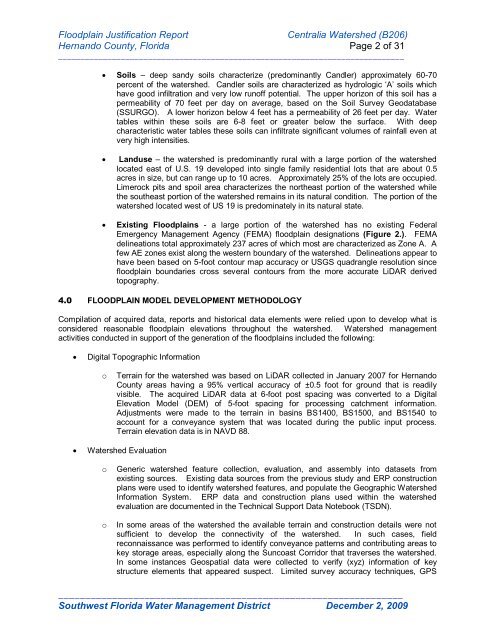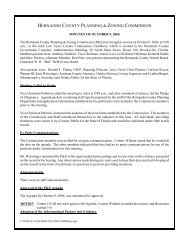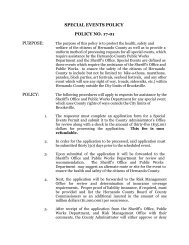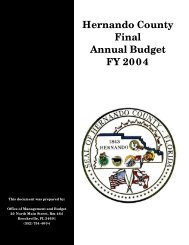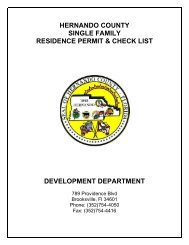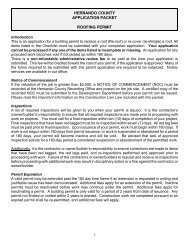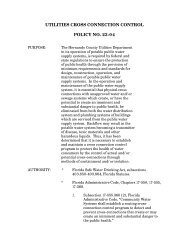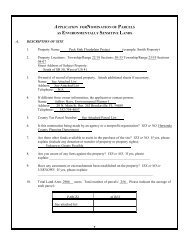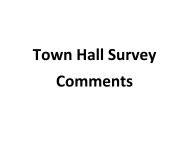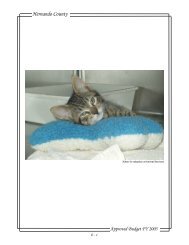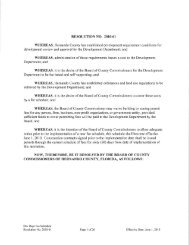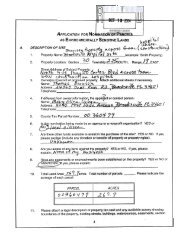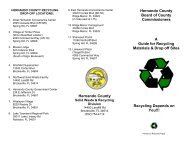Southwest Florida - Hernando County
Southwest Florida - Hernando County
Southwest Florida - Hernando County
- No tags were found...
You also want an ePaper? Increase the reach of your titles
YUMPU automatically turns print PDFs into web optimized ePapers that Google loves.
Floodplain Justification Report<br />
Centralia Watershed (B206)<br />
<strong>Hernando</strong> <strong>County</strong>, <strong>Florida</strong> Page 2 of 31<br />
_____________________________________________________________________________<br />
Soils – deep sandy soils characterize (predominantly Candler) approximately 60-70<br />
percent of the watershed. Candler soils are characterized as hydrologic „A‟ soils which<br />
have good infiltration and very low runoff potential. The upper horizon of this soil has a<br />
permeability of 70 feet per day on average, based on the Soil Survey Geodatabase<br />
(SSURGO). A lower horizon below 4 feet has a permeability of 26 feet per day. Water<br />
tables within these soils are 6-8 feet or greater below the surface. With deep<br />
characteristic water tables these soils can infiltrate significant volumes of rainfall even at<br />
very high intensities.<br />
<br />
<br />
Landuse – the watershed is predominantly rural with a large portion of the watershed<br />
located east of U.S. 19 developed into single family residential lots that are about 0.5<br />
acres in size, but can range up to 10 acres. Approximately 25% of the lots are occupied.<br />
Limerock pits and spoil area characterizes the northeast portion of the watershed while<br />
the southeast portion of the watershed remains in its natural condition. The portion of the<br />
watershed located west of US 19 is predominately in its natural state.<br />
Existing Floodplains - a large portion of the watershed has no existing Federal<br />
Emergency Management Agency (FEMA) floodplain designations (Figure 2.). FEMA<br />
delineations total approximately 237 acres of which most are characterized as Zone A. A<br />
few AE zones exist along the western boundary of the watershed. Delineations appear to<br />
have been based on 5-foot contour map accuracy or USGS quadrangle resolution since<br />
floodplain boundaries cross several contours from the more accurate LiDAR derived<br />
topography.<br />
4.0 FLOODPLAIN MODEL DEVELOPMENT METHODOLOGY<br />
Compilation of acquired data, reports and historical data elements were relied upon to develop what is<br />
considered reasonable floodplain elevations throughout the watershed. Watershed management<br />
activities conducted in support of the generation of the floodplains included the following:<br />
<br />
Digital Topographic Information<br />
o<br />
Terrain for the watershed was based on LiDAR collected in January 2007 for <strong>Hernando</strong><br />
<strong>County</strong> areas having a 95% vertical accuracy of ±0.5 foot for ground that is readily<br />
visible. The acquired LiDAR data at 6-foot post spacing was converted to a Digital<br />
Elevation Model (DEM) of 5-foot spacing for processing catchment information.<br />
Adjustments were made to the terrain in basins BS1400, BS1500, and BS1540 to<br />
account for a conveyance system that was located during the public input process.<br />
Terrain elevation data is in NAVD 88.<br />
<br />
Watershed Evaluation<br />
o<br />
o<br />
Generic watershed feature collection, evaluation, and assembly into datasets from<br />
existing sources. Existing data sources from the previous study and ERP construction<br />
plans were used to identify watershed features, and populate the Geographic Watershed<br />
Information System. ERP data and construction plans used within the watershed<br />
evaluation are documented in the Technical Support Data Notebook (TSDN).<br />
In some areas of the watershed the available terrain and construction details were not<br />
sufficient to develop the connectivity of the watershed. In such cases, field<br />
reconnaissance was performed to identify conveyance patterns and contributing areas to<br />
key storage areas, especially along the Suncoast Corridor that traverses the watershed.<br />
In some instances Geospatial data were collected to verify (xyz) information of key<br />
structure elements that appeared suspect. Limited survey accuracy techniques, GPS<br />
________________________________________________________________<br />
<strong>Southwest</strong> <strong>Florida</strong> Water Management District December 2, 2009


